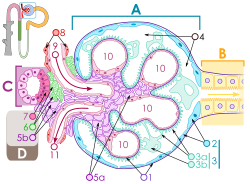Podocyte
| Podocyte | |||
|---|---|---|---|
 Renal corpuscle structure
Blood flows in the afferent arteriole (9) at the top, and out the efferent arteriole (11) at the bottom. Blood flows through the capillaries of the glomerulus (10), where it is filtered by pressure. The podocytes (3a and 3b, green) are wrapped around the capillaries. Blood is filtered through the slit diaphragm (or filtration slit), between the feet or processes of the podocytes. The filtered urine passes out the proximal tubule (B, yellow) on the right.
| |||
 Glomerulus. (Diagram in French, but "Membrane basale glomerulaire et ses podocytes" labeled near center.) | |||
| Details | |||
| Identifiers | |||
| Latin | podocytus | ||
| MeSH | D050199 | ||
| FMA | 70967 | ||
| Anatomical terminology | |||
Podocytes (or visceral epithelial cells) are cells in the Bowman's capsule in the kidneys that wrap around the capillaries of the glomerulus.[1] The Bowman's capsule filters blood, holding back large molecules such as proteins, and passing through small molecules such as water, salts, and sugar, as the first step in forming urine.
The long processes, or "foot projections," of the podocytes wrap around the capillaries, and leave slits between them. Blood is filtered through these slits, each known as a slit diaphragm or filtration slit. Several proteins are required for the foot projections to wrap around the capillaries and function. When infants are born with certain defects in these proteins, such as nephrin and CD2AP, their kidneys cannot function. People have variations in these proteins, and some variations may predispose them to kidney failure later in life. Nephrin is a zipper-like protein that forms the slit diaphragm, with spaces between the teeth of the zipper, big enough to allow sugar and water through, but too small to allow proteins through. Nephron defects are responsible for congenital kidney failure. CD2AP regulates the podocyte cytoskeleton and stabilizes the slit diaphragm.[2][3]
Function
Adjacent podocytes interdigitate to cover the basal lamina which is intimately associated with the glomerular capillaries, but the podocytes leave gaps or thin filtration slits.
The slits are covered by slit diaphragms which are composed of a number of cell-surface proteins including nephrin, podocalyxin, and P-cadherin, which ensure that large macromolecules such as serum albumin and gamma globulin remain in the bloodstream.
Small molecules such as water, glucose, and ionic salts are able to pass through the slit diaphragms and form an ultrafiltrate[4] which is further processed by the nephron to produce urine.
Podocytes are also involved in regulation of glomerular filtration rate (GFR). When podocytes contract, they cause closure of filtration slits. This decreases the GFR by reducing the surface area available for filtration.
Structure features
Structural features of podocytes indicate a high rate of vesicular traffic in these cells. Many coated vesicles and coated pits can be seen along the basolateral domain of the podocytes.
In their cell bodies, podocytes possess a well-developed endoplasmic reticulum and a large Golgi apparatus, indicative of a high capacity for protein synthesis and post-translational modifications.
There is also growing evidence of a large number of multivesicular bodies and other lysosomal components seen in these cells, indicating a high endocytic activity.
"Pedicles" (or "foot processes") extend from the podocyte and increase the surface area which is crucial for the efficiency of ultrafiltration.[5]
Pathology
Disruption of the slit diaphragms or destruction of the podocytes can lead to massive proteinuria where large amounts of protein are lost from the blood.
An example of this occurs in the congenital disorder Finnish-type nephrosis, which is characterised by neonatal proteinuria leading to end-stage renal failure. This disease has been found to be caused by a mutation in the nephrin gene.
See also
Additional images
-
Filtration barrier
References
- ^ "Podocyte" at Dorland's Medical Dictionary
- ^ First components found for key kidney filter, Ingrid Wickelgren, Science, 8 October 1999, 286:225
- ^ Attention: This template ({{cite pmid}}) is deprecated. To cite the publication identified by PMID 19562370, please use {{cite journal}} with
|pmid=19562370instead. - ^ Template:EMedicineDictionary
- ^ Template:GeorgiaPhysiology
External links
- Anatomy photo: Urinary/mammal/vasc1/vasc1 - Comparative Organology at University of California, Davis - "Mammal, renal vasculature (EM, High)
- Histology image: 22401loa – Histology Learning System at Boston University - ". Ultrastructure of the Cell: podocytes and glomerular capillaries"
- UIUC Histology Subject 1400
- podocyte.ca at Samuel Lunenfeld Research Institute

